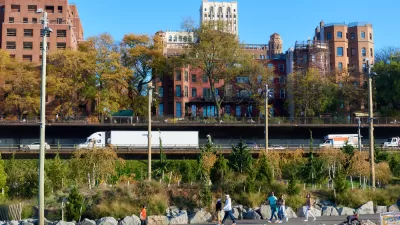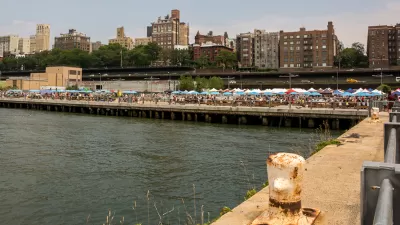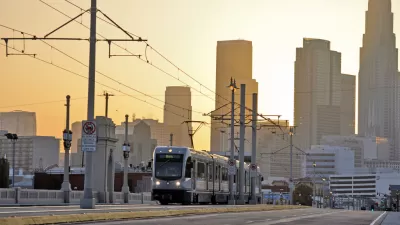Lisa W. Foderaro reports on a new deal that enables adaptive reuse of historic structures and commercial development at Brooklyn Bridge Park, and ends a long-simmering dispute.
Brooklyn Bridge Park is clearing the way for commercial development in the area formerly known as Empire Fulton Ferry Park. The Tobacco Warehouse, currently a brick shell from the Civil War Era, and Empire Stores will be redeveloped into a cultural facility and commercial retail complex. Brooklyn Bridge Park was developed beginning in 2007 as part of a chain of parks along the East River, which will incorporate the Brooklyn Greenway. When the project is completed the East River will be flanked by a series of parks and a continuous bike path similar in concept to Boston's Emerald Necklace. The park currently incorporates Pier 1, Pier 6, and Empire Fulton Ferry into a series of playgrounds, seating, natural landscapes, and, most recently, a restored carousel encased in a glass box designed by Jean Nouvel.
The existing Tobacco warehouse shell sits on a natural beach with a small strip of sand and and rocks bordered by tall native grasses. The site provides a pleasant alternative to the heavily landscaped hills south of the Brooklyn Bridge. The warehouse was initially promised to St. Ann's Warehouse, a local avant-garde theatre which has been in the neighborhood since 2000. Last July, a Federal District Court ruled against St. Ann's occupation of the site warning it would set a dangerous precedent for both historic properties and park land to be threatened by commercial interests.
Senator Daniel L. Squadron and Assemblywoman Joan L. Millman helped broker the development agreement in response to the court's injunction. In exchange for Empire Stores and Tobacco Warehouse, the state will donate one acre of parkland, which will be planned through a community design process.
Despite the agreement of neighborhood associations, critics claim much of the land already feels privatized. For critics, the trend of privatizing public space through commercial enterprise is a mounting concern as many cities are seeking ways to fund park maintenance in light of depleted budgets.
Thanks to Elaine Mahoney
FULL STORY: Deal Allows Development in Brooklyn Bridge Park

Trump Administration Could Effectively End Housing Voucher Program
Federal officials are eyeing major cuts to the Section 8 program that helps millions of low-income households pay rent.

Planetizen Federal Action Tracker
A weekly monitor of how Trump’s orders and actions are impacting planners and planning in America.

The 120 Year Old Tiny Home Villages That Sheltered San Francisco’s Earthquake Refugees
More than a century ago, San Francisco mobilized to house thousands of residents displaced by the 1906 earthquake. Could their strategy offer a model for the present?

HSR Reaches Key Settlement in Northern California City
The state’s high-speed rail authority reached an agreement with Millbrae, a key city on the train’s proposed route to San Francisco.

Washington State Legislature Passes Parking Reform Bill
A bill that would limit parking requirements for new developments is headed to the governor’s desk.

Missouri Law Would Ban Protections for Housing Voucher Users
A state law seeks to overturn source-of-income discrimination bans passed by several Missouri cities.
Urban Design for Planners 1: Software Tools
This six-course series explores essential urban design concepts using open source software and equips planners with the tools they need to participate fully in the urban design process.
Planning for Universal Design
Learn the tools for implementing Universal Design in planning regulations.
Ada County Highway District
Clanton & Associates, Inc.
Jessamine County Fiscal Court
Institute for Housing and Urban Development Studies (IHS)
City of Grandview
Harvard GSD Executive Education
Toledo-Lucas County Plan Commissions
Salt Lake City
NYU Wagner Graduate School of Public Service





























